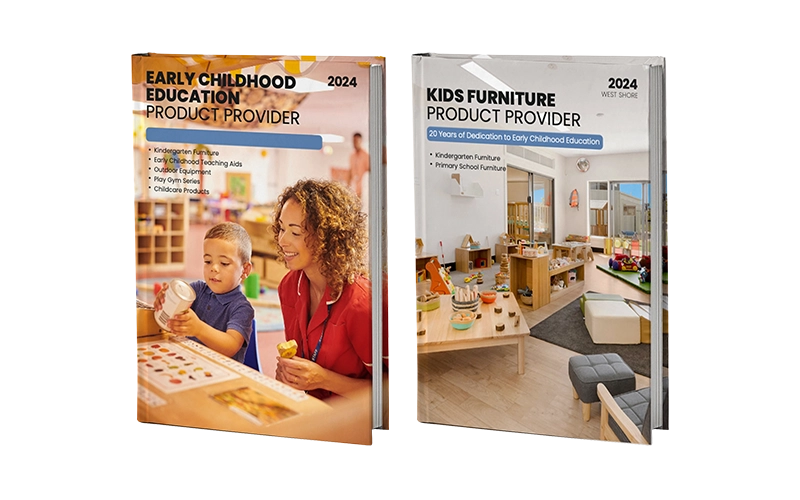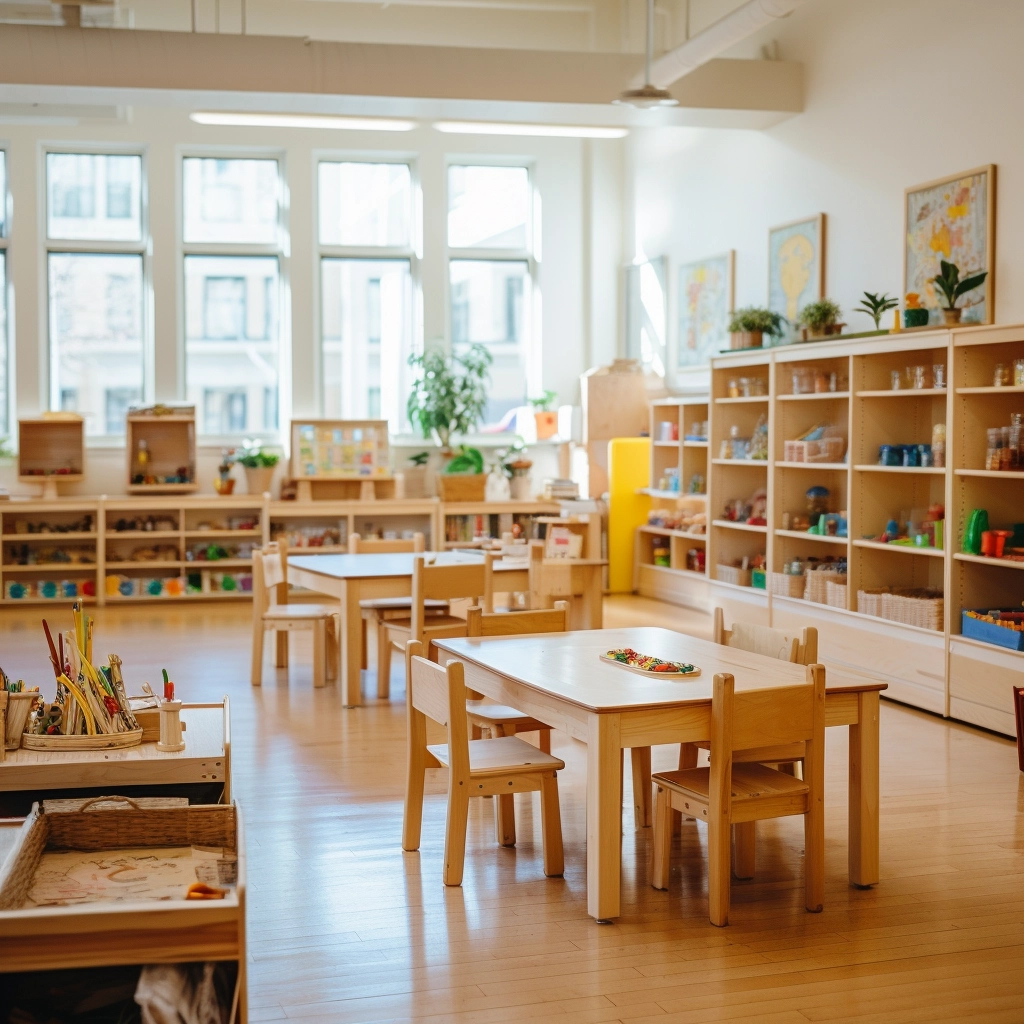Step into a world where imagination and learning go hand in hand! Have you ever wondered how the right classroom theme could transform your preschool environment into an exciting and engaging space for children? Do you find keeping young minds stimulated and excited about learning challenging? Does your classroom need a creative spark to make learning fun and educational?
The solution is simple: embracing creative preschool classroom themes! By selecting the right theme, you can easily create an environment that fosters curiosity, encourages exploration, and makes learning feel like an exciting adventure. If you’re a preschool teacher, these themes will turn your space into a vibrant, engaging, and interactive learning hub. With the right decorations, activities, and themes, you can transform any preschool, kindergarten, or daycare setting into an inspiring place where children are eager to learn.
In this guide, we’ve curated 18 creative preschool classroom themes perfect for sparking imagination and enhancing development. These themes will transform your classroom into a vibrant, interactive space and engage children in sensory-rich experiences that promote active play and discovery. Get ready to embark on an exciting journey through various theme ideas for kindergartens, nurseries, daycare centers, and even home environments – all designed to make learning an unforgettable adventure!

What Is Preschool Classroom Themes?
Preschool classroom themes are a highly effective tool for creating an engaging, fun, and educational environment for young learners. Using a preschool-themed classroom, educators can transform the classroom into an immersive space that invites children to explore, learn, and grow. These themes revolve around a central concept, idea, or motif reflected throughout the school via decorations, activities, and even the organization of learning materials. The benefits of incorporating preschool classroom theme ideas into your space are vast, allowing children to experience a well-structured environment that sparks their creativity and curiosity.
One of the most substantial aspects of a preschool theme classroom is allowing educators to organize learning materials and activities around a unifying concept. This makes it easier for children to draw connections between what they see, hear, and do throughout the day. A well-organized classroom theme idea for preschool also makes it easier for children to navigate through different areas of the classroom, allowing them to become more independent and confident in their exploration.

What Are Thematic Units?
A thematic unit is a teaching approach in which lessons are structured around a central theme. The concept behind thematic units is that children can gain a deeper understanding while developing related skills in various areas by focusing on one idea or subject.
In the context of preschool classroom themes, thematic units help teachers create a cohesive and engaging environment that ties together various learning activities. For instance, if the theme is “under the sea,” children may learn about ocean animals, make fish-shaped crafts, and practice reading by listening to stories about underwater adventures. This interdisciplinary approach promotes the development of multiple skills at once, making learning more integrated and meaningful.
Thematic units are often used in preschool and early childhood education because they foster classroom themes preschool that encourage children to make connections across subjects. By organizing activities around a central idea, children can see how concepts from different areas of learning connect. This helps them build a more comprehensive understanding of the topic and strengthens their ability to apply knowledge in other contexts.

Benefits of Decorating Preschool Classroom Themes
When creating a preschool classroom, the décor goes beyond just a visual touch. It plays an essential role in setting the atmosphere for learning and engagement. Using creative preschool classroom decor themes in your décor benefits children and educators. Let’s explore why decorating your classroom with a thoughtful theme is so beneficial:
Promotes Imagination and Creativity
Children thrive in environments that stimulate their imagination, and a well-decorated classroom with a creative preschool-themed classroom encourages them to think beyond the ordinary. Children are encouraged to engage in pretend play and creative exploration. This imaginative environment supports creativity and problem-solving skills as children navigate theme-based activities.
Creates a Sense of Belonging and Comfort
A preschool classroom theme helps make the space feel welcoming and familiar, fostering a sense of belonging and comfort for young learners. When the classroom environment reflects a unifying theme, such as “under the sea” or “jungle safari,” it serves as a visual cue that helps children understand their surroundings.
Children who feel secure and comfortable in their classroom are more likely to engage in learning and participate actively in activities. This emotional comfort can contribute to a positive classroom experience, especially for younger children or those in daycare classroom themes who may be adjusting to a new space.

Enhances Learning
Classroom themes in preschool help organize the learning environment into different, purposeful areas that promote specific learning experiences. Whether it’s a reading nook for a “storybook” theme or a science corner for a “space” theme, themes allow children to engage with the material more hands-on and meaningfully. Teachers can seamlessly integrate educational concepts into the theme, allowing children to explore and learn through play.
Supports Early Literacy and Language Skills
Thematic decoration exposes children to a broader vocabulary and related concepts, making it an excellent tool for supporting classroom themes for preschool. For example, a “farm” theme introduces children to animal names, sounds, and farming vocabulary. A preschool theme classroom like “transportation” will introduce words like “engine,” “bus,” and “track,” which will expand their language skills in a natural and engaging context.

Provides a Structured Environment
One key benefit of using preschool classroom themes is that they help create a structured environment that is easy for children to navigate. A transparent organization with visual cues based on a theme allows children to understand their space better, which helps them transition smoothly between activities. This structure is fundamental in daycare classroom themes, where younger children may be learning how to follow routines.
In addition, classroom theme ideas for preschool can also help children grasp time management. Thematic units such as “farm animals” or “seasons” can be broken into smaller learning sections that reflect different aspects of the subject, providing a predictable routine and a sense of security and control for preschoolers.

Preschool Classroom Themes Considerations
While choosing a theme for your preschool classroom can be an exciting and creative process, several important factors must be considered to ensure the theme will be effective and appropriate for the children. Below are key considerations when deciding on the correct preschool classroom theme for your space:
- Understanding level and interests: The theme chosen should be developmentally appropriate for preschool-aged children. This means that the theme’s complexity, the activities involved, and the materials used should be suitable for the children’s cognitive, emotional, and physical development. Young learners need to connect with the theme in a way that supports their learning style. The concept should be simple enough to be understood by children while still offering opportunities to expand their knowledge and skills.
- Flexibility and Adaptability: Preschool classrooms are dynamic environments where learning needs can change daily. Therefore, a theme should be flexible enough to allow for modification and adaptation over time. As you assess the needs and interests of the children, it may become necessary to adjust activities, materials, or even the scope of the theme to suit the group better. Themes should be broad enough to encompass multiple learning areas, such as social-emotional development, creativity, literacy, and numeracy, while also allowing for spontaneous learning moments that may arise.
- Diversity and Inclusivity: Choosing pre-k classroom themes that promote diversity, inclusion, and cultural awareness is essential. A preschool classroom should be a welcoming space where all children feel represented and valued. The theme should not inadvertently exclude or marginalize certain groups of children or reinforce stereotypes. By selecting an inclusive theme that reflects a variety of experiences, backgrounds, and perspectives, you create a learning environment where every child can see themselves and feel a sense of belonging. For instance, a theme like “Community Helpers” can include diverse occupations from different cultures and communities.
- Integration with Curriculum Objectives: While themes are an excellent way to make learning more engaging, they should also align with the educational goals and objectives of the preschool curriculum. The theme should not overshadow the fundamental learning outcomes, such as language development, social skills, motor skills, and early math and science concepts. By integrating the theme with your curriculum objectives, you can ensure that the learning is both fun and meaningful. Each activity, lesson, or project that falls under the theme should contribute to a greater understanding of these core areas.
- Practicality and Resource Availability: Consider the availability of resources when selecting a theme. Some themes may require more resources in terms of materials, decorations, and educational props than others. While creating an immersive and vibrant environment is essential, you must also ensure that the materials required to implement the theme are within your budget and easily accessible. Additionally, ensure the theme doesn’t need constant replenishment or expensive supplies that may not be feasible in the long run. Themes that can be brought to life with common materials or easily created with the children’s help tend to be more practical and sustainable.
How to Create a Preschool Classroom Theme?
Creating a preschool classroom theme is an exciting and creative process. Below are the steps to help you develop and implement your theme most effectively:
1. Choose a Theme That Aligns With Learning Goals
The first step in creating a preschool theme classroom is selecting a theme that aligns with your educational goals. Whether your focus is on science, literature, emotions, or social studies, the theme should support your curriculum and help guide your teaching approach.Consider how the theme can connect with multiple areas of learning. Themes like “space” or “jungle” often have built-in opportunities for STEM learning (science, technology, engineering, and math) that naturally tie into children’s curiosity about the world around them. Your preschool classroom theme ideas should be crafted to engage children in various cognitive, physical, and emotional developmental areas.

2. Design a Thematic Learning Environment
Once you’ve chosen your preschool classroom theme, the next step is to design the space to reflect the theme and create a cohesive atmosphere. This involves using decorations, furniture, and learning materials that support the central theme. You should also consider creating specific learning areas based on the theme. These could include a sensory area where children explore textures related to the theme (e.g., “moon rocks” for a space theme or “leaves” for a forest theme), a reading corner filled with books related to the theme, or an art station where children can create their version of the theme, like painting their planets or making jungle animal masks.

3. Incorporate Multi-Sensory Activities
Engage all of the children’s senses with your chosen theme. A preschool classroom theme is more than just a visual experience; it should be multi-sensory to promote deeper engagement and brain development.
This multi-sensory approach helps reinforce the theme while providing valuable learning experiences. Whether it’s a “farm” theme with animal sounds, a “pirate adventure” with role-play materials, or a “weather wonders” theme with raindrops or snowflakes (actual or simulated), sensory play encourages discovery, creativity, and learning.

4. Integrate Themed Learning Materials
Incorporate themed learning materials to ensure the theme extends into every corner of the classroom. Use books, songs, toys, and games related to the theme to keep children engaged and immersed in the subject.
Preschool classroom theme ideas can also extend beyond traditional materials. You can introduce preschool classroom decor themes that match the topic, such as space-themed wall art, a “jungle corner” filled with animal plush toys, or farm-themed mats for a play area. Integrating learning materials that reflect the theme ensures that children are surrounded by a consistent narrative, helping them make connections between the materials and what they are learning.

5. Engage Children in Creative Activities
Set up creative activities encouraging children to express themselves while learning about the theme. These hands-on activities allow children to explore creatively while learning about the animals and plants found in a jungle environment.
Creative activities related to the theme help children connect the subject matter with their personal experiences, whether it’s a space exploration theme where children make their rockets or a cute preschool classroom theme like “Rainbow Wonderland,” where children can create colorful patterns and designs. These activities also enhance fine motor skills, social interaction, and the development of artistic expression.

18 Creative Preschool Classroom Themes
Choosing a creative and stimulating theme for a preschool classroom is essential in fostering a positive and engaging environment for young children. The right theme sets the stage for interactive play, learning, and social development. Here are 20 creative preschool classroom themes to spark children’s imaginations and support their learning journeys.
1. Under the Sea Preschool Classroom Themes
“Under the Sea” is a timeless and enchanting preschool classroom theme that invites children into the fascinating world of marine life. This theme is about exploring ocean creatures, underwater environments, and the sea’s mysteries. Perfect for capturing young imaginations, it encourages learning about sea animals, ecosystems, and even ocean conservation in a fun, interactive way. An under-the-sea theme sparks curiosity and promotes a deep understanding of the ocean’s biodiversity.
To bring the “Under the Sea” preschool classroom theme to life, decorate the walls with large, colorful murals of underwater scenes featuring fish, turtles, and seaweed. You can also create 3D ocean creatures by hanging cut-out sea animals from the ceiling to simulate them swimming around the room. Add soft, ocean-colored fabrics like blues, greens, and teals to the windows and furniture to mimic the calming hues of the ocean.

2. Animal Safari Preschool Classroom Themes
An “Animal Safari” preschool theme is perfect for classrooms filled with energy and curiosity. Children are naturally fascinated by animals, and this theme brings the wild jungle or savannah into the school. It provides a fun opportunity to learn about various species, their habitats, and even animal sounds while encouraging imaginative play. An Animal Safari theme encourages children to explore the animal kingdom and understand the diversity of wildlife engagingly and interactively.
For an exciting “Animal Safari” setup, create jungle-inspired corners with lush green plants (real or artificial) and vines draped from the ceiling to simulate a dense rainforest. Set up different animal stations with large animal posters or 3D cutouts of lions, elephants, giraffes, and monkeys, which can help children identify and learn about other species.

3. Space Exploration Preschool Classroom Themes
The “Space Exploration” preschool classroom theme is perfect for inspiring young minds to look up to the stars and beyond. With its focus on space travel, planets, astronauts, and distant galaxies, this theme sparks curiosity about the universe and encourages children to dream big about future possibilities. It’s an engaging way to introduce basic science concepts, such as the solar system, in a fun and imaginative way, helping to build a foundation for early childhood preschool classroom themes focused on science and exploration.
To create an exciting “Space Exploration” classroom, start with a dark black or navy blue wall backdrop. Glow-in-the-dark stars and planets can bring the solar system to life, adding a sense of mystery and wonder. Hang large cutouts of rockets, astronauts, and planets from the ceiling or make a space station corner with toy spaceships and space-themed books.
Use a “mission control” station with space-related books, puzzles, and activities about planets and stars for the learning areas. Encourage children to dress up as astronauts with costume helmets and space suits. A sensory area with silver or metallic materials (like foil) mimicking the texture of space could be fun, too. Add music from space-themed movies or ambient space sounds to complete the experience. Kids can engage in space-themed arts and crafts, creating planets or designing astronaut helmets. The “space” theme can also be adapted to a preschool theme classroom by adding interactive, hands-on learning experiences for young children.

4. Rainbow Wonderland Preschool Classroom Themes
A “Rainbow Wonderland” preschool classroom theme is an explosion of color and fun, making it a perfect way to stimulate creativity and engage young learners. This theme introduces children to colors and their interaction while encouraging exploring patterns and sorting. The vibrant, cheerful atmosphere makes it easy to create a joyful learning space where children feel welcome to explore and engage with the materials. It’s an ideal classroom theme for preschool that supports learning through visual stimulation.
A fun addition could be a “rainbow sensory corner” where children can explore items in each color—different colored blocks, fabrics, or even foods (like colored fruits) for a hands-on experience. For arts and crafts, set up an activity where children can create their rainbow using paper, markers, and crayons. This theme is also perfect for introducing basic concepts like sorting by color, making patterns, and exploring the science of light and color. Incorporating preschool classroom decor themes like rainbow-colored cushions and classroom accessories can make this theme even more immersive.

5. Farmyard Fun Preschool Classroom Themes
The “Farmyard Fun” theme brings the charm of the countryside into the classroom. It’s ideal for teaching children about animals, farming, and nature in a fun, relatable way. Children can learn about life on a farm, including where their food comes from, how animals live, and what it takes to run a farm. This preschool classroom theme is an excellent way to promote early literacy, social studies, and basic math skills in a playful, engaging environment.
Start by setting the scene with hay bales or soft seating arranged to look like a barn. You can decorate with farm animal posters (like cows, chickens, and pigs) or set up cardboard cutouts to bring the farm to life. Create a pretend play area with a “farm stand” where children can “sell” farm produce like apples, pumpkins, and eggs.
For the sensory area, fill a sandbox with “dirt” and plastic farm animal figurines so children can recreate farm life. Consider setting up a small garden theme for classroom with potted plants for children to water and observe how they grow. The learning areas include farm-themed books, puzzles, and counting activities using farm animals to help develop math skills. This preschool theme classroom idea offers plenty of opportunities for hands-on learning while supporting early math and literacy skills. It also works perfectly for preschool classroom themes of nature and the environment.

6. Transportation Preschool Classroom Themes
The “Transportation” preschool classroom theme is perfect for preschoolers fascinated by vehicles and how they move. From cars to trains to airplanes, this theme provides an excellent opportunity to teach children about different modes of transportation and the importance of travel in our everyday lives. The preschool theme classroom encourages exploration of how vehicles work and allows young learners to engage in various transportation-related educational activities.
Transform the classroom into a bustling transportation hub by decorating with images of cars, trucks, trains, and planes. Create a “road” on the floor using tape or fabric where children can roll toy cars and trucks. Set up a train station corner with a toy train set or create a “bus stop” reading nook with comfy seating and bus-themed decor.
For hands-on learning, use cardboard boxes to create toy vehicles like buses, cars, and airplanes, and let children decorate and play in them. You can also incorporate activities like traffic light sorting or building roads using blocks. Set up a small area for pretend play where kids can “drive” toy cars or “fly” planes using props. This theme encourages movement, coordination, and understanding of how transportation impacts our daily lives. It’s perfect for preschool theme ideas promoting physical activity, role-play, and interactive learning experiences.

7. Dinosaur Discovery Preschool Classroom Themes
The “Dinosaur Discovery” preschool classroom theme is an exciting way to introduce preschoolers to the prehistoric world. Dinosaurs capture the imagination of young learners, making them the perfect subject for creative exploration. This theme provides an opportunity to discuss the history of dinosaurs, their types, and the concept of fossils—all while engaging children in hands-on activities and creative play. A preschool classroom theme like this encourages learning through imaginative exploration and a deeper understanding of Earth’s ancient history.
To create a “Dinosaur Discovery” classroom, start by covering the walls with dinosaur footprints and images of species like T. rex, Velociraptor, and Triceratops. Use green, brown, and earthy tones to decorate the room to evoke a prehistoric jungle feel. Hang large cutouts of dinosaurs from the ceiling to create a “dinosaur zoo” effect, making the classroom feel right in the middle of a dinosaur park.
For the sensory area, you can create a “fossil dig” station, where children can “unearth” toy dinosaurs buried in sand or rice. Consider using playdough or clay for a “fossil-making” activity, where children can make their fossil imprints with plastic dinosaur figures. Incorporate dinosaur-themed books and puzzles to enhance literacy and problem-solving skills. A dino-themed dress-up station with dinosaur costumes could also encourage imaginative play. This classroom themes preschool approach adds layers of fun while reinforcing foundational science concepts.
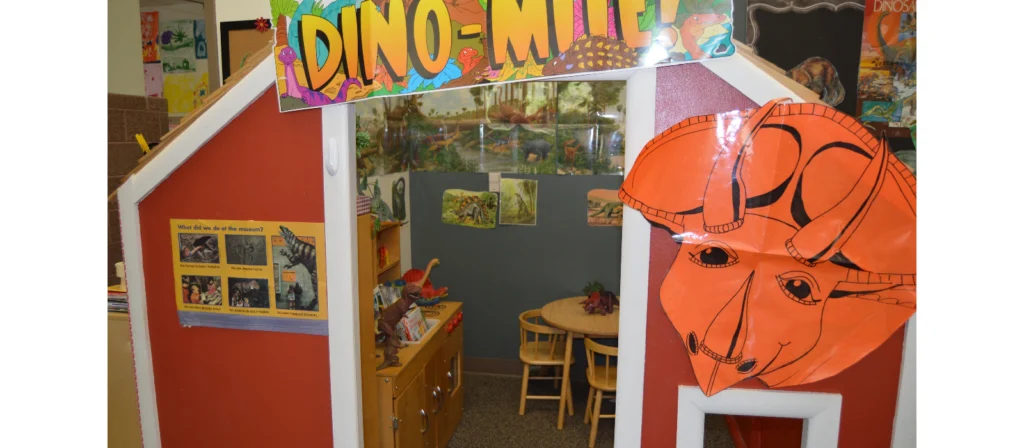
8. Circus Fun Preschool Classroom Themes
A “Circus Fun” preschool classroom theme will bring joy and excitement to your preschool classroom. This vibrant and lively theme provides endless imaginative play, creativity, and learning opportunities. Children will love exploring circus acts, learning about different performers, and even trying simple circus skills like juggling or clowning around. A preschool-themed classroom based on the circus fosters social interaction as children work together to “perform” in the circus, develop their motor skills, and build self-confidence.
To bring the circus to life in the classroom, start with bright, bold colors like red, yellow, and blue to create a carnival atmosphere. Use striped fabric to build tent-like structures or hang up colorful banners with circus-related images such as elephants, clowns, and acrobats. You could also set up a “ticket booth” or “concession stand” as part of the decor for a fun, interactive space.
For interactive activities, you can create a juggling station using scarves or bean bags and a “clown nose” station to make funny faces with mirrors. Set up a pretend play area with circus animals like lions and elephants, or create a “circus parade” where children can march around the classroom in costume. Use circus music for added fun during transitions and activities. A craft corner can focus on making circus-themed items, such as animal masks or clown hats. This theme is a perfect example of themes for preschool classrooms that combine physical activity and imagination.
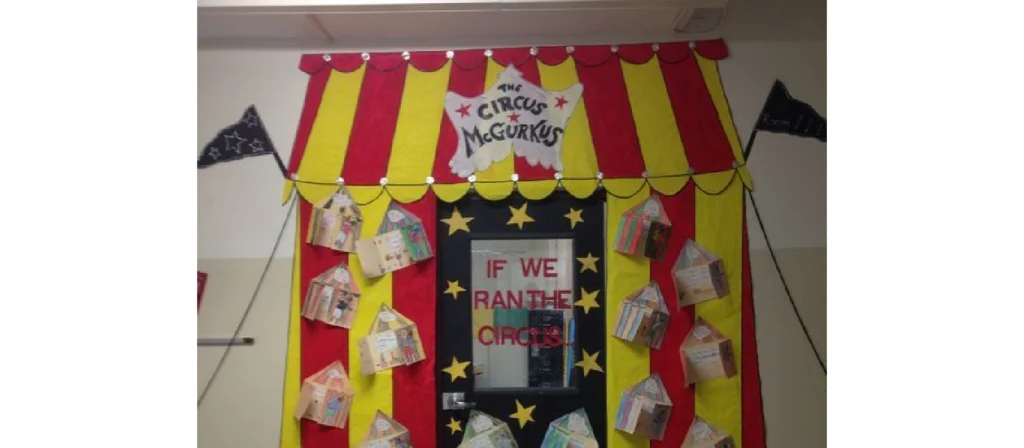
9. Fairy Tales and Fantasy Preschool Classroom Themes
A “Fairy Tales and Fantasy” preschool classroom theme transports children into the magical world of princes, princesses, dragons, and castles. This theme allows children to explore stories and characters from beloved fairy tales while encouraging creativity, storytelling, and role-playing. It’s an ideal way to foster a love for literature and spark the imagination of young learners. A preschool classroom theme like this supports early literacy development, emotional growth, and social skills as children bring the stories to life through play.
Transform the classroom into a magical kingdom with fairy tale decor. Use soft pastel colors like pink, purple, and gold to create a whimsical and enchanted atmosphere. Decorate the walls with murals of castles, forests, and mythical creatures like unicorns and fairies. Hang twinkling lights to mimic the sparkle of fairy dust or the glow of a magical kingdom.
Incorporate fairy tale books, puppet shows, and dramatic play areas where children can pretend to be their favorite characters. A castle dress-up corner could be filled with crowns, princess dresses, and knight armor for children to act out their fairy tale adventures. Encourage storytelling with props like magic wands or toy dragons, and use music from fairy tale movies to create an immersive atmosphere. Children can also create fairytale-inspired crafts, like dragon masks or princess crowns. This preschool classroom theme helps foster literacy, creativity, and social interaction in an engaging, immersive setting.

10. Community Helpers Preschool Classroom Themes
The “Community Helpers” preschool classroom theme introduces children to the important roles people play in society. From firefighters and police officers to teachers and doctors, this theme teaches children about different jobs and how these individuals contribute to the community. It encourages respect for others while fostering a deeper understanding of how everyone plays a part in keeping society running smoothly.
Set up interactive stations like a “doctor’s office” with medical supplies, a “fire station” with pretend equipment, and a “post office” for sorting letters. This theme is perfect for classroom themes for preschool as it provides an opportunity for children to engage in pretend play, social development, and learning about the world of work.

11. Ancient Egypt Preschool Classroom Themes
The “Ancient Egypt” preschool classroom theme introduces children to the mysteries of one of the world’s most fascinating ancient civilizations. This theme offers a rich learning experience that sparks curiosity and imagination, from pyramids and pharaohs to hieroglyphics and the Nile River. It’s an ideal way to introduce children to history, geography, and basic archaeology, all while fostering creativity.
To bring “Ancient Egypt” to life in the classroom, decorate with images of pyramids, sphinxes, pharaohs, and hieroglyphic symbols. You can create a corner with “ancient artifacts” such as golden coins, scarabs, and Egyptian-style decorations. Add color accents like gold, sand, and rich jewel tones to give the classroom an authentic, historical feel.
For hands-on activities, set up an animal sensory station where children can touch toy animals, textures like faux fur or leaves, or even jungle animal figurines hidden in “mud” or sand. Create a “safari vehicle” for pretend play—a cardboard box or play vehicle where children can sit and pretend they’re on a safari expedition. Include books about jungle animals, and let children explore different jungle-related crafts, such as making animal masks or painting jungle scenes. Adding role-play elements that support emotional development can further enhance this preschool classroom theme.

12. Houses and Homes Preschool Classroom Themes
The “Houses and Homes” preschool classroom theme allows children to explore the concepts of home, family, and community. It’s a great way to introduce children to different types of homes worldwide, the importance of shelter, and what makes a home a special place. This theme fosters social-emotional development as children learn about family dynamics and begin to understand their place within a larger community.
To bring the “Houses and Homes” theme to life, start by decorating the classroom with images of different types of homes—such as houses, apartments, and cottages—alongside illustrations of homes worldwide. Create a cozy “living room” corner with soft seating and play props like mini furniture or small house-themed toys. A sensory station could include materials such as fabric swatches, wooden blocks, and tiny toy houses, allowing children to build and explore various types of homes.
For pretend play, set up a “kitchen” or “bedroom” area where children can role-play tasks like cooking meals or tidying up. Include preschool classroom theme ideas that teach children about family members and what each person contributes to the household. You could even set up a “mail station” where children can pretend to send and receive letters or packages, reinforcing the idea of communication within the community.

13. Light and Shadow Preschool Classroom Themes
The “Light and Shadow” preschool classroom theme is an excellent way to introduce children to basic science concepts, such as how light works and shadows are formed. This theme encourages curiosity and hands-on exploration, helping children understand the properties of light, color, and shadow. It also creates an ideal environment for imaginative play, as children can make their shadow puppets or explore light and color through art and games.
To create a “Light and Shadow” classroom, use light-colored walls to enhance the effect of shadows and play with contrast. Set up different stations with materials like translucent colored sheets, flashlights, or a lightbox for children to experiment with light and colors. Hang paper cutouts of trees, animals, or objects and project shadows onto the walls for children to trace or guess.
In the sensory area, provide materials like mirrors, translucent fabric, and light-up toys to encourage children to explore the relationship between light and shadow. Use shadow puppets or create a “shadow theater” for children to put on their performances. This theme is excellent for preschool classroom activities focusing on understanding the physical world interactively and engagingly.

14. Manners Preschool Classroom Themes
The “Manners” preschool classroom theme is a fantastic way to teach children the importance of kindness, respect, and good behavior. This theme allows children to learn about everyday manners, such as saying “please,” “thank you,” and “excuse me.” It helps build a foundation for positive social interactions and empathy, encouraging children to practice being thoughtful and considerate of others.
Set up scenarios where children can practice their manners—such as a pretend tea party, restaurant, or store where they can practice greeting one another and using polite phrases. A “thank you” board where children can write or draw something they are grateful for would encourage reflection and kindness. Incorporating preschool theme classroom elements like this helps children learn the value of empathy and cooperation in a fun, interactive way.

15. Nutrition Preschool Classroom Themes
The “Nutrition” preschool classroom theme is an ideal way to introduce children to healthy eating habits and the importance of food in maintaining a balanced lifestyle. This theme can help children understand where food comes from, the benefits of different food groups, and how healthy eating impacts their bodies. By exploring preschool classroom themes related to nutrition, children understand the connection between the foods they eat and their overall well-being.
Set up a pretend play station where children can “shop” for healthy foods or prepare “healthy meals” using toy food. You can also introduce sensory stations where children can touch real fruits, vegetables, or other food items to understand their textures and smells better. Preschool classroom theme ideas like this provide an engaging way to teach healthy eating habits while fostering social interactions through group meal preparation and shared activities.

16. Doctor’s Office Preschool Classroom Themes
The “Doctor’s Office” preschool classroom theme introduces children to the world of healthcare and teaches them the critical roles doctors and nurses play in keeping people healthy. This theme allows children to explore medical tools, understand the importance of health and hygiene, and foster empathy through pretend play. The preschool classroom theme encourages kids to understand the value of caring for their bodies and helps reduce fear about doctor visits.
Set up a pretend play area where children can act as doctors, patients, and nurses, checking vitals or treating “injured” dolls. Incorporate preschool classroom decor themes such as healthy lifestyle posters (e.g., eating healthy, brushing teeth, etc.) to reinforce positive habits. You can also use preschool theme classroom ideas like creating simple medical charts or a “healthy body” craft station where children can learn anatomy by building body shapes or creating their stethoscopes.

17. Science Lab Preschool Classroom Themes
The “Science Lab” preschool classroom theme is perfect for sparking young children’s curiosity about the world around them. This theme introduces them to the basics of science, encouraging them to experiment, observe, and discover new things through hands-on activities. Whether it’s simple experiments with colors, light, or nature, this theme helps build foundational science concepts and critical thinking skills.
For hands-on activities, use sensory materials like colored water, magnets, or textured objects for children to explore. Encourage children to wear lab coats and safety glasses while experimenting. Create a “discovery zone” with different science-themed puzzles, books, and games. This preschool classroom theme is perfect for engaging kids in problem-solving and sparking their natural curiosity.
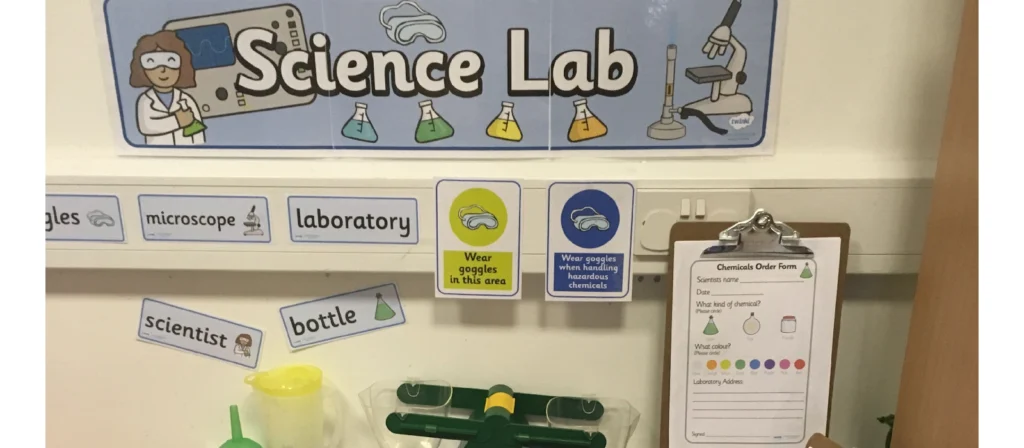
18. Pirate Adventure Preschool Classroom Themes
The “Pirate Adventure” preschool classroom theme brings the excitement of high seas adventure to your classroom. Children will love engaging in imaginative play as they pretend to be pirates, discover treasure, and explore unknown islands. This theme encourages teamwork, problem-solving, and creativity, allowing children to learn about maps, navigation, and even the basics of history and exploration.
To create a “Pirate Adventure” classroom, decorate with bold, nautical colors like red, black, and gold. To set the scene, hang pirate flags, maps, and treasure chests around the room. Using cardboard boxes and old wood planks in the corner, create a “pirate ship” where children can pretend to sail the seven seas.

Practical Tips for Effective Preschool Theme Implementation
Several essential tips and strategies can help make a preschool classroom theme engaging and educational for young learners. The right preschool classroom theme can spark curiosity and creativity, but ensuring it is easy to implement and works well with your teaching objectives is essential.
Focus on the Interests of Your Students
When selecting a preschool-themed classroom, start by considering your students’ interests. For example, if the children are particularly fascinated by animals, a “Jungle Safari” or “Farmyard Fun” theme might be an excellent choice. Incorporating the children’s interests into the theme will increase their engagement and enthusiasm about the activities.
Use Simple, Interactive Learning Materials
Young children learn best when they can engage with the material hands-on. Use themed learning materials that are simple, interactive, and appropriate for their developmental stage. For example, for a “Transportation” theme, provide toy cars, trucks, and trains that children can use to explore how different vehicles work. Similarly, in a preschool jungle-themed classroom, stuffed animals, books, and sensory bins filled with jungle materials (like leaves or vines) can help children engage more deeply with the content.

Incorporate Different Learning Styles
Every child learns differently, and incorporating multiple learning styles can enhance the overall impact of your preschool classroom theme. Some children are visual learners, so colorful posters and thematic wall decorations will help. Others may learn better through hands-on activities, so interactive stations or sensory areas related to the theme will be beneficial. For example, in a “Dinosaur Discovery” theme, some children may enjoy listening to stories about dinosaurs. In contrast, others will love engaging with tactile sensory bins filled with sand and toy fossils.
Plan Activities That Are Fun and Educational
Ensure that the activities related to the theme are fun and aligned with your learning objectives. For example, a “Rainbow Wonderland” theme could include sorting colored blocks, making art projects based on color mixing, and learning about the science of light and colors. These activities support creativity and build fundamental academic skills like sorting, pattern recognition, and early science concepts.
Creating a Safe and Engaging Learning Space for Preschool Themes
Creating a safe, comfortable, and stimulating learning environment is essential for the success of any preschool-themed classroom. When children feel safe and comfortable, they are more likely to engage in the activities and participate actively in learning. Here’s how to create an environment where preschoolers can thrive while exploring exciting themes.
Safety First: Set Up Secure Learning Areas
Ensure your classroom is free from hazards, especially when working with small children. Secure heavy objects, sharp materials, or items that could easily be knocked over during play. When designing your preschool classroom theme, ensure the furniture and materials are child-friendly and have enough space for children to move around freely.
Establish Defined Learning Zones
Different themes often require different activities, so consider dividing the classroom into clearly defined learning zones. This approach helps children understand where to go for each activity and encourages them to move seamlessly between areas, allowing for a well-rounded experience within the preschool classroom themes.

Incorporate Comfort into Your Design
Since preschoolers spend much time in the classroom, creating a comfortable and welcoming space is essential. Use cozy corners with pillows, blankets, or soft mats to create a relaxing reading or quiet play area. Adding soft textures to the environment is especially important for younger children, as tactile exploration supports sensory development.
Design a Stimulating Visual Environment
Children are highly visual learners, so make sure your classroom is visually stimulating without being overwhelming. Incorporate bright colors, thematic decorations, and interactive visuals that draw children into the theme. Use wall decals, posters, or murals representing your theme. This makes the classroom feel dynamic and reinforces the theme in a way that engages children.
Maintaining and Updating Preschool Classroom Themes
Preserving the excitement of a preschool-themed classroom throughout the school year requires thoughtful preschool planning themes and periodic updates. Keeping the theme fresh and dynamic is essential to sustain the children’s interest while reinforcing educational concepts. Here are some strategies for maintaining and updating your theme as the year progresses.
Rotate Learning Materials
To keep children excited about each topic, it’s important to refresh the activities regularly when planning your daycare theme week ideas. As kids become familiar with a theme, such as “Transportation,” rotating learning materials can help maintain their interest. You might introduce new toy cars, trucks, or trains, or add engaging educational resources like maps, road signs, or traffic light activities. Regularly updating the materials encourages children to explore fresh aspects of the theme and stay actively engaged.
Seasonal Adjustments
As the seasons change, so should your preschool classroom themes. You can introduce seasonal changes to reinforce the theme and keep the environment fresh.

Incorporate Student Input
Incorporating the children’s ideas and interests is one great way to keep your preschool room theme engaging and up-to-date. Ask them what they want to learn next or what part of the theme they enjoy most. Allowing children to participate in decision-making helps them feel more invested in the theme and gives them ownership over the learning process.
Refresh Decor and Activities
You can also refresh the theme by adding new activities and decor to reinforce the learning objectives. Change up the art projects or sensory stations to keep the children engaged with the theme in fresh ways.
The Role of Teachers in Implementing and Sustaining Preschool Classroom Themes
Teachers play a pivotal role in the success of preschool decor ideas. Their involvement shapes the implementation and ensures the theme remains relevant and engaging throughout the year. Here’s how teachers can take the lead in implementing and maintaining preschool classroom themes effectively.
Planning and Preparation
Effective preschool theme classroom implementation begins with careful planning. Teachers should outline their learning objectives and choose a theme that aligns with their curriculum goals. Once the theme is selected, teachers must gather materials, set up the classroom, and design learning activities to support the theme.
Fostering Engagement
A teacher’s role in fostering engagement is crucial. Teachers should create opportunities for children to participate in the theme through guided activities, collaborative group projects, or individual exploration.

Assessing Learning Progress
Teachers should assess the children’s learning progress as the theme evolves to ensure they meet developmental milestones. They can observe and track how well children grasp key concepts related to the theme and adjust activities as needed.
Keeping the Theme Dynamic
To sustain the theme’s excitement, teachers need to continuously refresh materials, update activities, and introduce new concepts. They also need to remain flexible and adapt the theme to suit the children’s interests and learning needs.
Conclusion
By carefully designing preschool classroom themes, educators enhance the learning experience, encourage children to connect with their surroundings, and deepen their understanding of the world. Themes like “Animal Safari,” “Space Exploration,” and “Fairy Tale Kingdom” create dynamic and interactive spaces where children can explore new concepts in fun and meaningful ways, helping them build essential skills for their future education.
We understand the importance of designing functional and stimulating learning environments at West Shore Furniture. With over 20 years of experience, we specialize in providing high-quality preschool furniture that complements any theme. From classroom design and custom furniture solutions to production, quality checks, and timely delivery, we offer a comprehensive one-stop service. Our wide range of preschool furniture, available in various styles, materials, and sizes, is designed to meet the unique needs of modern classrooms, helping teachers bring their educational themes to life effortlessly.
Frequently Asked Questions
1. What are popular themes for decorating a toddler classroom?
Popular themes for decorating a toddler classroom include “Under the Sea,” “Animal Safari,” “Rainbow Wonderland,” and “Farmyard Fun.” These themes engage toddlers with vibrant colors, playful animals, and simple educational concepts that are easy for young learners to explore.
2. How can I find unique themes for my preschool classroom?
To find unique themes for your preschool classroom, consider your students’ interests and developmental needs. Explore themes like “Space Exploration,” “Dinosaur Discovery,” or “Jungle Safari” to add excitement and learning opportunities. You can also get creative by blending two themes, like combining “Pirate Adventure” with “Treasure Hunt” for a more personalized learning experience.
3. Where can I get free printable materials for preschool classroom themes?
You can find free printable materials for preschool classroom themes on websites like Teachers Pay Teachers, Pinterest, and education blogs. Many sites offer free downloads for posters, worksheets, and activity sheets related to popular themes like “Under the Sea,” “Transportation,” or “Fairy Tales.”
4. How should I set up my preschool classroom according to a specific theme?
To set up your preschool classroom according to a specific theme, start by designing different learning zones (e.g., reading nook, sensory station, pretend play area) that reflect the theme. For example, in a “Pirate Adventure” setup, create a “treasure chest” corner for books and props, and decorate the walls with pirate flags, maps, and ship elements. Make sure to incorporate interactive materials and sensory-rich items like fabric textures, toys, and visual aids that complement the theme.
5. Can I change themes throughout the year?
Yes, changing themes throughout the year can keep the classroom fresh and exciting. This approach can help maintain children’s interest and introduce new learning concepts.





